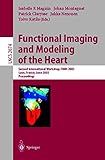Functional Imaging and Modeling of the Heart [electronic resource] : Second International Workshop, FIMH 2003, Lyon, France, June 5-6, 2003, Proceedings /
Material type: TextSeries: Lecture Notes in Computer Science ; 2674Publisher: Berlin, Heidelberg : Springer Berlin Heidelberg : Imprint: Springer, 2003Edition: 1st ed. 2003Description: XI, 311 p. online resourceContent type:
TextSeries: Lecture Notes in Computer Science ; 2674Publisher: Berlin, Heidelberg : Springer Berlin Heidelberg : Imprint: Springer, 2003Edition: 1st ed. 2003Description: XI, 311 p. online resourceContent type: - text
- computer
- online resource
- 9783540448839
- 611 23
- 571.3 23
- QL801-950.9
Invited Speakers -- Tagged MRI-Based Studies of Cardiac Function -- A Novel Method for Quantifying the Contribution of Different Intracellular Mechanisms to Mechanically Induced Changes in Action Potential Characteristics -- Session 1: Anatomy Extraction and Description -- Automatic Construction of Biventricular Statistical Shape Models -- Visualising Cardiac Anatomy Using Constructive Volume Geometry -- Evaluation of a 3D Segmentation Software for the Coronary Characterization in Multi-slice Computed Tomography -- A Levelset Based Method for Segmenting the Heart in 3D+T Gated SPECT Images -- Session 2: Modeling of the Cardiac Mechanics and Functions -- Modeling of Electro-mechanical Coupling in Cardiac Myocytes: Feedback Mechanisms and Cooperativity -- Simulating Cardiac Mechanoenergetics in the Left Ventricle -- Towards Patient Specific Models of Cardiac Mechanics: A Sensitivity Study -- Does the Collagen Network Contribute to Normal Systolic Left Ventricular Wall Thickening? A Theoretical Study in Continuum Mechanics -- Session 3: Electro-physiology, Electro-, and Magnetography -- Regularization in Cardiac Source Imaging -- On the Influence of a Volume Conductor on the Orientation of Currents in a Thin Cardiac issue -- First 36-Channel Magnetocardiographic Study of CAD Patients in an Unshielded Laboratory for Interventional and Intensive Cardiac Care -- Heterogeneous Sinoatrial Node of Rabbit Heart - Molecular and Electrical Mapping and Biophysical Reconstruction -- Session 4: Motion Estimation -- Construction of a Cardiac Motion Atlas from MR Using Non-rigid Registration -- Motion-Compensation of Cardiac Perfusion MRI Using a Statistical Texture Ensemble -- Measuring Myocardial Deformations in Tagged MR Image Sequences Using Informational Non-rigid Registration -- Parametric Analysis ofMain Motion to Study the Regional Wall Motion of the Left Ventricle in Echocardiography -- Modeling and Tracking of the Cardiac Left Ventricular Motion by a State Space Harmonic Model in MRI Sequence -- Session 5: Image Registration and Image Analysis -- A Strategy to Quantitatively Evaluate MRI/PET Cardiac Rigid Registration Methods Using a Monte Carlo Simulator -- Spatio-temporal Alignment of 4D Cardiac MR Images -- Automatic Registration of MR First-Pass Myocardial Perfusion Images -- Evaluation and Comparison of Surface and Intensity Based Rigid Registration Methods for Thorax and Cardiac MR and PET Images -- Left Ventricular Flow Dynamics and Transmural Gradients in Myofiber Shortening with MRI-Tagging -- Intravascular Ultrasound Images Vessel Characterization Using AdaBoost -- Motion Analysis of 3D Ultrasound Texture Patterns -- Session 6: Data Acquisition, Experimental, and Modeling Studies -- Estimation of the Diastolic Intraventricular Relative Pressures Using MRI Acceleration Measurements -- Magnetic Resonance Fusion Imaging of Chronic Myocardial Ischemia -- The Relationship between Regional Integrated Backscatter Levels and Regional Strain in Normal, Acutely Ischemic, and Reperfused Myocardium -- Why Ischemic Hearts Respond Less to Cardiac Resynchronisation Therapy. A Modeling Study -- Finite Element Models for Mechanical Simulation of Coronary Arteries.
The ?rst international conference on Functional Imaging and Modeling of the 1 Heart (FIMH) was held in Helsinki, Finland, in November 2001, thanks to the strongscienti?ccollaborationbetweenFranceandFinland. Thiseventwasa?rst attempt to federate the heart imaging community and to encourage collabo- tion between scientists in signal and image processing, applied mathematics and physics, biomedical engineering and computer science, and experts in card- logy, radiology, biology, and physiology, in Europe and beyond. The conference has encountered considerable success. The outstanding research works pres- ted have demonstrated a very active research ?eld with complex modeling and image analysis problems to be solved. One of the outcomes was the special issue of the Medical Image Analysis journal based on a selection of the conference’s best papers, to appear in the second half of 2003. The FIMH 2001 meeting was the starting point of a discussion for federating the European research e?ort in cardiac imaging, heart modeling, and cardiac image analysis. It was very successful, and a large coalition was created around 2 the e-Heart proposal for a Network of Excellence in the European Sixth Fra- work Program. The e-Heart network has already gathered about 200 researchers from 100 institutes. A project proposal has been submitted to the European Union. It was decided in the ?rst meeting to organize a regular biennial conference.


There are no comments on this title.